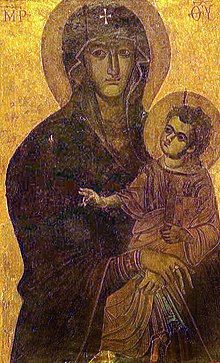
Back السيدة العذراء (تصوير) Arabic Мадона (католицизъм) Bulgarian Madonna (art) Catalan مادۆنا (ھونەر) CKB Madona Czech Marienbildnis German Maria kun infano Esperanto Virgen con Niño Spanish Madonna Estonian Madonna (artea) Basque

| Part of a series on the |
| Mariology of the Catholic Church |
|---|
 |
|
|



In art, a Madonna (Italian: [maˈdɔnna]) is a representation of Mary, either alone or with her child Jesus. These images are central icons for both the Catholic and Orthodox churches.[1] The word is from Italian ma donna 'my lady' (archaic). The Madonna and Child type is very prevalent in Christian iconography, divided into many traditional subtypes especially in Eastern Orthodox iconography, often known after the location of a notable icon of the type, such as the Theotokos of Vladimir, Agiosoritissa, Blachernitissa, etc., or descriptive of the depicted posture, as in Hodegetria, Eleusa, etc.
The term Madonna in the sense of "picture or statue of the Virgin Mary" enters English usage in the 17th century, primarily in reference to works of the Italian Renaissance. In an Eastern Orthodox context, such images are typically known as Theotokos. "Madonna" may be generally used of representations of Mary, with or without the infant Jesus, where she is the focus and central figure of the image, possibly flanked or surrounded by angels or saints. Other types of Marian imagery that have a narrative context, depicting scenes from the Life of the Virgin, e.g. the Annunciation to Mary, are not typically called "Madonna".
The earliest depictions of Mary date to Early Christian art of the (2nd to 3rd centuries, found in the Catacombs of Rome.[2] These are in a narrative context. The classical "Madonna" or "Theotokos" imagery develops from the 5th century, as Marian devotion rose to great importance after the Council of Ephesus formally affirmed her status as "Mother of God or Theotokos ("God-bearer") in 431.[3] The Theotokos iconography as it developed in the 6th to 8th century rose to great importance in the high medieval period (12th to 14th centuries) both in the Eastern Orthodox and in the Latin spheres.
According to a tradition first recorded in the 8th century, and still strong in the Eastern Church, the iconography of images of Mary goes back to a portrait drawn from life by Luke the Evangelist, with a number of icons (such as the Panagia Portaitissa) claimed to either represent this original icon or to be a direct copy of it. In the Western tradition, depictions of the Madonna were greatly diversified by Renaissance masters such as Duccio, Leonardo da Vinci, Michelangelo, Raphael, Giovanni Bellini, Caravaggio, and Rubens (and further by certain modernists such as Salvador Dalí and Henry Moore), while Eastern Orthodox iconography adheres more closely to the inherited traditional types.
- ^ Doniger, Wendy, Merriam-Webster's encyclopedia of world religions Archived 2022-12-30 at the Wayback Machine, 1999, ISBN 0-87779-044-2 p. 696.
- ^ Mary in Western Art Archived 2022-12-30 at the Wayback Machine by Timothy Verdon, Filippo Rossi 2005 ISBN 0-9712981-9-X p. 11
- ^ Burke, Raymond, Mariology: A Guide for Priests, Deacons, Seminarians, and Consecrated Persons Archived 2022-12-30 at the Wayback Machine 2008 ISBN 1-57918-355-7 [page needed]
© MMXXIII Rich X Search. We shall prevail. All rights reserved. Rich X Search